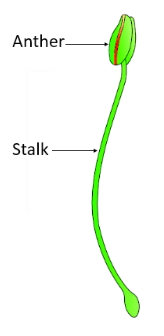
Write the male parts of the flower.
Answer
513.6k+ views
Hint: These are found in flowering plants and are responsible for conducting pollination as pollen grains are present on them which are bright yellow in colour and attract insects that help in pollination.
Complete answer:
The male parts of the flower are collectively called the stamen. It is the reproductive part of a plant. The stamen consists of the anther at the top and the stalk or filament (slender,thread-like object) that supports the anther, at the bottom. The anther produces pollen grains, it is a sac-like circular structure that is yellowish. Stamen is also called Androecium. The stamen is responsible for pollination, i.e, transfer of pollen grains from Stamen to Pistil. The stamen is found in Gymnosperms, i.e, flowering plants. All the stamen do not have fertile anthers. Stamen is said to be the third whorl of a flower. Calyx, corolla, androecium, and gynoecium are the four whorls of a flower. Small secretory structures, called nectaries, are often found at the bottom of the stamens; they supply food rewards for insect and bird pollinators.

Diagram showing male parts of flower
Note: -The anther contains microsporangia. Each microsporangium contains pollen mother cells. These undergo meiosis and produce pollen grains, which contain the male gametes (sperm).
-The pollen grains are haploid male gametophytes.
-The pollen is released when the anther opens. The pollen is carried by some agent (wind, or some animal) to the receptive surface of the stigma of an equivalent or another flower. This process is known as pollination.
-The number of stamens is often the same as the number of petals. The presence of numerous stamens is common in many plant families; most orchids possess only one stamen.
Complete answer:
The male parts of the flower are collectively called the stamen. It is the reproductive part of a plant. The stamen consists of the anther at the top and the stalk or filament (slender,thread-like object) that supports the anther, at the bottom. The anther produces pollen grains, it is a sac-like circular structure that is yellowish. Stamen is also called Androecium. The stamen is responsible for pollination, i.e, transfer of pollen grains from Stamen to Pistil. The stamen is found in Gymnosperms, i.e, flowering plants. All the stamen do not have fertile anthers. Stamen is said to be the third whorl of a flower. Calyx, corolla, androecium, and gynoecium are the four whorls of a flower. Small secretory structures, called nectaries, are often found at the bottom of the stamens; they supply food rewards for insect and bird pollinators.

Diagram showing male parts of flower
Note: -The anther contains microsporangia. Each microsporangium contains pollen mother cells. These undergo meiosis and produce pollen grains, which contain the male gametes (sperm).
-The pollen grains are haploid male gametophytes.
-The pollen is released when the anther opens. The pollen is carried by some agent (wind, or some animal) to the receptive surface of the stigma of an equivalent or another flower. This process is known as pollination.
-The number of stamens is often the same as the number of petals. The presence of numerous stamens is common in many plant families; most orchids possess only one stamen.
Recently Updated Pages
Master Class 11 Physics: Engaging Questions & Answers for Success

Master Class 11 Chemistry: Engaging Questions & Answers for Success

Master Class 11 Biology: Engaging Questions & Answers for Success

Class 11 Question and Answer - Your Ultimate Solutions Guide

Master Class 11 Business Studies: Engaging Questions & Answers for Success

Master Class 11 Computer Science: Engaging Questions & Answers for Success

Trending doubts
Explain why it is said like that Mock drill is use class 11 social science CBSE

Which of the following blood vessels in the circulatory class 11 biology CBSE

Difference Between Prokaryotic Cells and Eukaryotic Cells

1 ton equals to A 100 kg B 1000 kg C 10 kg D 10000 class 11 physics CBSE

One Metric ton is equal to kg A 10000 B 1000 C 100 class 11 physics CBSE

Which one is a true fish A Jellyfish B Starfish C Dogfish class 11 biology CBSE




